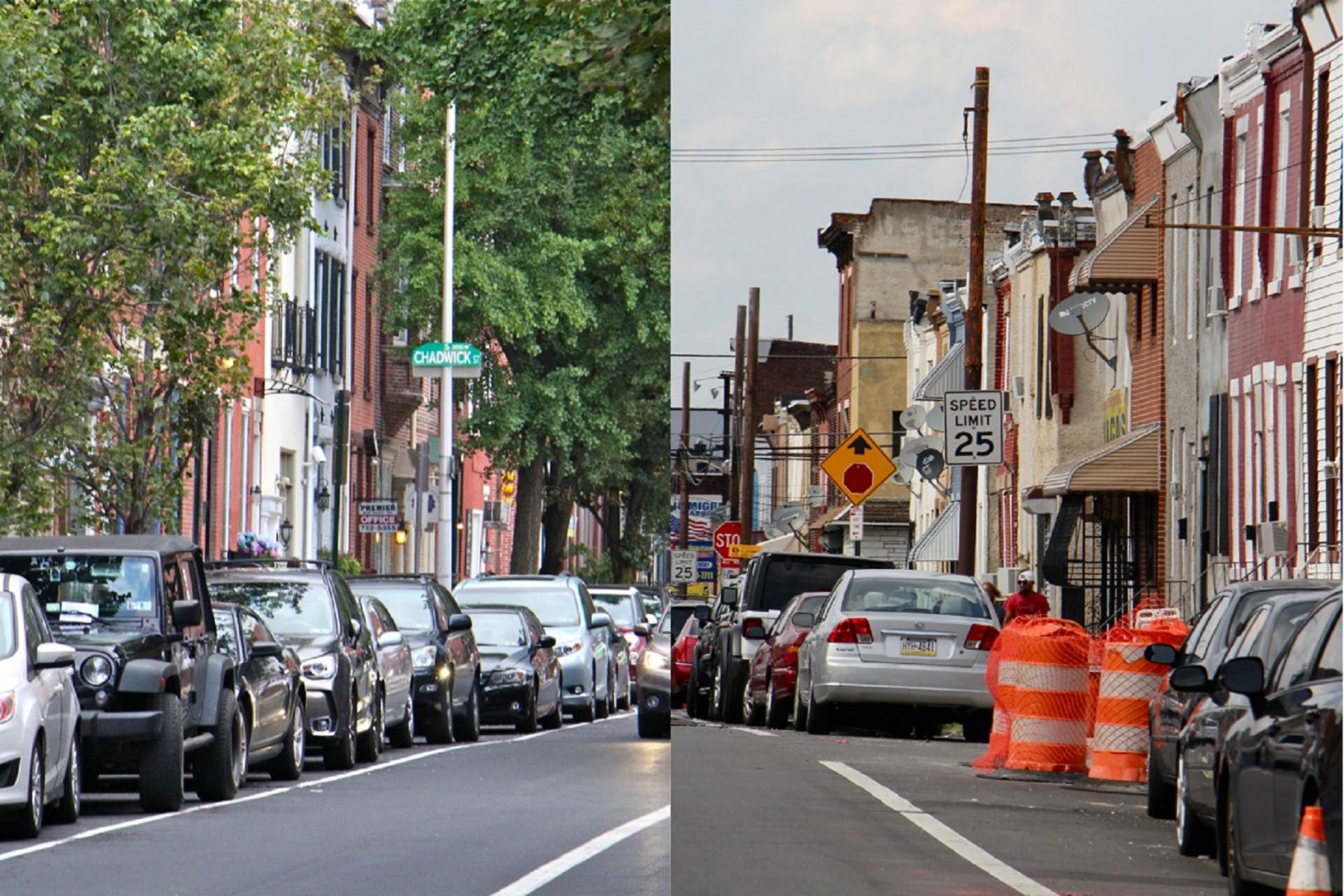
Leafy Pine Street in Center City is contrasted with treeless North 5th Street in Hunting Park.
Emma Lee / WHYY

Leafy Pine Street in Center City is contrasted with treeless North 5th Street in Hunting Park.
Emma Lee / WHYY

Emma Lee / WHYY
Leafy Pine Street in Center City is contrasted with treeless North 5th Street in Hunting Park.
(Philadelphia) — Philadelphia has lost the equivalent of over 1,000 football fields worth of tree cover over the last decade, according to a new city report.
That 6% loss comes at a time when the city is working to increase the amount of green in the city and address chronic disparities that have left Philly’s low-income neighborhoods with fewer trees and as a result, hotter temperatures and less protection against the impact of climate change. City officials kicked off a first-ever ‘urban forest’ strategic planning process last week. The reduction in tree cover discovered by researchers will lay the groundwork for the 10-year plan to dramatically increase the city’s leafy cover.
“Because climate change is going to impact how livable our cities are — how hot they are, how we feel on the streets and in our houses even — losing trees is definitely a big problem, because we need them to shade our homes, to provide windbreak, to capture stormwater,” said Erica Smith Fichman, Philadelphia Parks & Recreation community forestry manager.
Today, just 20% of all city land is covered by trees but Fichman and her team want to get to 30% canopy by 2025.
The report, which tracks tree losses and gains from 2008 to 2018, is an attempt to map how the city’s tree population is faring as government and various partners work to reverse historic trends that have left some parts of the city barren and others, lush. Working with groups like Esperanza in Hunting Park, the city has planted thousands of trees in parks, streets and residential yards. More than 24,000 have been given away by the city since 2012 yet the report revealed that a new approach is needed if the city wants to erase inequities that are, quite literally, rooted deep.
“We’re going to […] step back and say: how are we doing the work and is it impacting the people that need it the most?,” said Smith Fichman.
Equity has been a “driving priority” of the city’s tree-planting program since it began in 2012, said Smith Fichman.
“The strategic plan will take this same approach and deepen the impact we have already seen in communities around Philadelphia.”
One thing that could change as a result of the planning is the system used to distribute free street trees. Residents who want a leafy addition to their block now request through an application process. But not everyone knows about the option and more applications tend to come from areas that already have more trees, aggravating disparities.
“[The report] helps us make the case for changes that we want to make, and for other people to tell us what their priorities are,” said Smith Fichman.
The urban forest plan will also explore how residents think about trees and their role in a healthy environment. The city’s tree assessment shows that most of the trees lost in the last 10 years are in residential areas — many of them in Northeast Philly — and that they’re not dying of natural cases.
“A lot of the trees that we’ve lost in the last ten years are only about 40 or 50 feet tall which indicates that they are more like in the middle of their lifespan,” said Smith Fichman. “That also indicates that they’re […] being removed, or falling from storms, or dying from other types of environmental stresses.”
Although most people like trees, not everyone wants them on their sidewalk because they see them as a burden or a threat. Trees are also being removed by development and new construction, according to the report. The city hopes the urban forest plan will provide recommendations on how to work with community organizations and city agencies to support “a more tree-friendly culture” across all neighborhoods.
But not everything is a loss — and there’s room to grow. In the last 10 years 1,980 acres of tree canopy were also gained, most of it also in residential areas. Smith Fichman says most of the trees planted by the city in the last years are not showing in the report done with aerial imagery because they’re still too young to show a cover. But some planted in South Philadelphia around the FDR Park boosted the tree canopy in that area. According to the tree assessment, there are over 20,000 acres of land where the city can plant trees. Most of them are in residential areas in the city’s Northeast, Southwest and Northwest.
Smith Fichman says another goal of the urban forest plan is to question the need of having a universal goal of 30% canopy in every neighborhood, when some neighborhoods clearly have more needs and opportunities than others.
The city will release a request for proposals to choose a team of consultants for the plan, titled “The Future of the Urban Forest,” early next year. The planning process which will include public meetings, focus groups and surveys, is expected to take between 12 and 18 months with funds from a grant from the William Penn Foundation and support from TD Bank.
WHYY is the leading public media station serving the Philadelphia region, including Delaware, South Jersey and Pennsylvania. This story originally appeared on WHYY.org.
The days of journalism’s one-way street of simply producing stories for the public have long been over. Now, it’s time to find better ways to interact with you and ensure we meet your high standards of what a credible media organization should be.